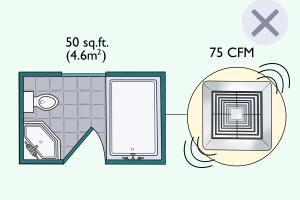Mastering CFM Calculation for Your Bathroom Fan: A Comprehensive Guide

-
Quick Links:
- Introduction
- What is CFM?
- Importance of CFM in Bathroom Fans
- How to Calculate CFM
- Step-by-Step Guide to Calculate CFM
- Common Mistakes to Avoid
- Real-World Examples
- Expert Insights
- Conclusion
- FAQs
Introduction
In today’s world, ensuring proper ventilation in your home is essential, especially in areas with high humidity like bathrooms. A key component in achieving effective ventilation is understanding how to calculate the Cubic Feet per Minute (CFM) required for your bathroom fan. This comprehensive guide will walk you through everything you need to know about CFM calculations, the importance of proper fan selection, and practical examples to ensure you make informed decisions.
What is CFM?
CFM, or Cubic Feet per Minute, is a measurement of the volume of air that a fan can move in one minute. It is a crucial metric for assessing the performance of exhaust fans, particularly in bathrooms where moisture and odors need to be efficiently removed.
Importance of CFM in Bathroom Fans
Choosing the right CFM rating for your bathroom fan is vital for ensuring effective air circulation. An insufficient CFM can lead to lingering humidity and odors, while an excessive CFM might result in unnecessary energy consumption and noise. Understanding CFM helps you:
- Prevent mold and mildew growth.
- Enhance indoor air quality.
- Maintain a comfortable atmosphere.
How to Calculate CFM
Calculating the CFM needed for your bathroom is relatively straightforward. The calculation primarily depends on the size of the bathroom, which is typically measured in square feet. The general guideline is to have 1 CFM for every square foot of bathroom space.
Step-by-Step Guide to Calculate CFM
Here’s a detailed step-by-step guide to help you calculate the CFM for your bathroom fan:
- Measure the Bathroom Size: Measure the length and width of your bathroom. Multiply these two dimensions to get the area in square feet.
- Determine the CFM Requirement: Use the guideline of 1 CFM per square foot to determine the minimum CFM required. For example, if your bathroom is 100 square feet, you need at least 100 CFM.
- Consider Additional Factors: If your bathroom has additional features such as a shower, bathtub, or toilet, you may need to increase your CFM requirement. A common practice is to add 50 CFM for a shower or bathtub.
Common Mistakes to Avoid
- Underestimating Bathroom Size: Ensure accurate measurements to avoid inadequate ventilation.
- Ignoring Additional Features: Always consider fixtures that may add to humidity levels.
- Overlooking Fan Placement: Proper placement affects efficiency; avoid installing fans too close to corners.
Real-World Examples
To illustrate the CFM calculation process, let’s consider a couple of real-world scenarios:
Example 1: Standard Bathroom
A standard bathroom measuring 10 feet by 8 feet has an area of 80 square feet. Following the 1 CFM per square foot guideline, the minimum required CFM would be 80.
Example 2: Bathroom with Shower
A larger bathroom measuring 12 feet by 10 feet (120 square feet) that includes a shower would require at least 120 CFM. Adding an additional 50 CFM for the shower brings the total to 170 CFM.
Expert Insights
To provide additional value, we reached out to ventilation experts and HVAC professionals. Their consensus highlights the importance of not only meeting the minimum CFM requirements but also considering factors like noise level and energy efficiency in fan selection.
Conclusion
Understanding how to calculate CFM for your bathroom fan is crucial for maintaining a healthy and comfortable living environment. By following the guidelines outlined in this article, you can ensure that your bathroom ventilation system is effective and efficient.
FAQs
1. What happens if my bathroom fan is too powerful?
If your bathroom fan has a higher CFM than necessary, it may lead to increased energy costs and excessive noise without significantly improving ventilation.
2. Can I use a bathroom fan in other areas of my home?
While bathroom fans are designed for specific moisture control, they can be used in other areas like laundry rooms, but ensure that the CFM rating matches the space size.
3. How often should I run my bathroom fan?
To effectively reduce humidity, run the fan during and for at least 15 minutes after showers or baths.
4. Do I need a timer for my bathroom fan?
A timer can be helpful to ensure the fan runs long enough to clear moisture without needing manual operation.
5. Can I install a bathroom fan myself?
If you have basic electrical and construction skills, you may install a bathroom fan. However, hiring a professional is advisable for safety and compliance with local building codes.
6. How do I maintain my bathroom fan?
Regularly clean the fan blades and housing to ensure optimal performance. Additionally, check for any obstructions in the ductwork.
7. What is the average noise level for bathroom fans?
Most bathroom fans operate between 0.5 to 3.0 sones, with quieter models being more desirable for home use.
8. Can humidity affect the CFM calculation?
Humidity itself doesn’t directly affect CFM calculation, but it does influence the necessity for a fan with a higher CFM rating to adequately control moisture levels.
9. Are there energy-efficient bathroom fans?
Yes, look for fans with ENERGY STAR ratings, which indicate they meet energy efficiency guidelines.
10. What should I consider when buying a bathroom fan?
Consider the CFM rating, noise level, energy efficiency, and additional features such as humidity sensors or timers.
Random Reads
- How to enable javascript in mozilla firefox
- How to set up ftp between two computers
- How to clean mold off ceiling
- Get the vengeful sun god requirements sacrifices
- Get rid of curry smell
- Hide porn on computer
- Hide apps samsung galaxy
- Hide wireless network
- How to clean a sofa
- How to clean a washing machine with vinegar